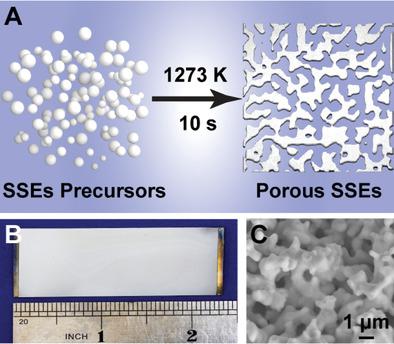当前位置:
X-MOL 学术
›
Adv. Mater.
›
论文详情
Our official English website, www.x-mol.net, welcomes your
feedback! (Note: you will need to create a separate account there.)
High-Temperature Ultrafast Sintering: Exploiting a New Kinetic Region to Fabricate Porous Solid-State Electrolyte Scaffolds
Advanced Materials ( IF 27.4 ) Pub Date : 2021-07-19 , DOI: 10.1002/adma.202100726 Ruiliu Wang 1 , Qi Dong 1 , Chengwei Wang 1 , Min Hong 1 , Jinlong Gao 1 , Hua Xie 1 , Miao Guo 1 , Weiwei Ping 1 , Xizheng Wang 1 , Shuaiming He 1 , Jian Luo 2 , Liangbing Hu 1, 3
Advanced Materials ( IF 27.4 ) Pub Date : 2021-07-19 , DOI: 10.1002/adma.202100726 Ruiliu Wang 1 , Qi Dong 1 , Chengwei Wang 1 , Min Hong 1 , Jinlong Gao 1 , Hua Xie 1 , Miao Guo 1 , Weiwei Ping 1 , Xizheng Wang 1 , Shuaiming He 1 , Jian Luo 2 , Liangbing Hu 1, 3
Affiliation

|
Solid-state batteries (SSBs) promise better safety and potentially higher energy density than the conventional liquid- or gel-based ones. In practice, the implementation of SSBs often necessitates 3D porous scaffolds made by ceramic solid-state electrolytes (SSEs). Herein, a general and facile method to sinter 3D porous scaffolds with a range of ceramic SSEs on various substrates at high temperature in seconds is reported. The high temperature enables rapid reactive sintering toward the desired crystalline phase and expedites the surface diffusion of grains for neck growth; meanwhile, the short sintering duration limits the coarsening, thus accurately controlling the degree of densification to preserve desired porous structures, as well as reducing the loss of volatile elements. As a proof-of-concept, a composite SSE with a good ionic conductivity (i.e., ≈1.9 × 10−4 S cm−1 at room temperature) is demonstrated by integrating poly(ethylene oxide) with the 3D porous Li6.5La3Zr1.5Ta0.5O12 scaffold sintered by this method. This method opens a new door toward sintering a variety of ceramic-SSE-based 3D scaffolds for all-solid-state battery applications.
中文翻译:

高温超快烧结:利用新的动力学区域来制造多孔固态电解质支架
与传统的液体或凝胶电池相比,固态电池 (SSB) 具有更好的安全性和潜在更高的能量密度。在实践中,SSB 的实施通常需要由陶瓷固态电解质 (SSE) 制成的 3D 多孔支架。本文报道了一种通用且简便的方法,可在几秒钟内在高温下在各种基材上烧结具有一系列陶瓷 SSE 的 3D 多孔支架。高温使快速反应烧结成为所需的结晶相,并加速晶粒的表面扩散以进行颈部生长;同时,较短的烧结时间限制了粗化,从而准确控制致密化程度以保持所需的多孔结构,并减少挥发性元素的损失。作为概念验证,-4 S cm -1在室温下)通过将聚(环氧乙烷)与通过该方法烧结的 3D 多孔 Li 6.5 La 3 Zr 1.5 Ta 0.5 O 12支架结合来证明。这种方法为烧结用于全固态电池应用的各种基于陶瓷 SSE 的 3D 支架打开了一扇新的大门。
更新日期:2021-08-25
中文翻译:

高温超快烧结:利用新的动力学区域来制造多孔固态电解质支架
与传统的液体或凝胶电池相比,固态电池 (SSB) 具有更好的安全性和潜在更高的能量密度。在实践中,SSB 的实施通常需要由陶瓷固态电解质 (SSE) 制成的 3D 多孔支架。本文报道了一种通用且简便的方法,可在几秒钟内在高温下在各种基材上烧结具有一系列陶瓷 SSE 的 3D 多孔支架。高温使快速反应烧结成为所需的结晶相,并加速晶粒的表面扩散以进行颈部生长;同时,较短的烧结时间限制了粗化,从而准确控制致密化程度以保持所需的多孔结构,并减少挥发性元素的损失。作为概念验证,-4 S cm -1在室温下)通过将聚(环氧乙烷)与通过该方法烧结的 3D 多孔 Li 6.5 La 3 Zr 1.5 Ta 0.5 O 12支架结合来证明。这种方法为烧结用于全固态电池应用的各种基于陶瓷 SSE 的 3D 支架打开了一扇新的大门。


















































 京公网安备 11010802027423号
京公网安备 11010802027423号